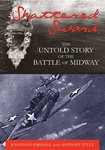syscom3
Pacific Historian
http://www.shatteredswordbook.com/
This has got to be one of the finest books on naval warfare in the Pacific. This was an excellent addition to my collection and if any of you go out and buy one, I swear you will not be dissapointed.
The authors look at the battle from the Japanese point of view, using documents that have long existed but never used in the western "story" of the battle.
Plenty of myths exist about what happened. The book looks at them all. Among them are:
# The Americans triumphed against overwhelming odds at the Battle of Midway.
# The Aleutians Operation was conceived by Admiral Yamamoto, the commander in chief of Combined Fleet, as a diversion designed to lure the American fleet out of Pearl Harbor.
# During the transit to Midway, Admiral Yamamoto withheld important intelligence information from Admiral Nagumo, the operational commander of the carrier striking force. As a result, Nagumo was in the dark concerning the nature of the threat facing him.
# Had the Japanese implemented a two-phase reconnaissance search on the morning of 4 June, they would have succeeded in locating the American fleet in time to win the battle.
# The late launch of cruiser Tone's No. 4 scout plane doomed Admiral Nagumo to defeat in the battle.
# Had Admiral Nagumo not decided to rearm his aircraft with land-attack weapons, he would have been in a position to attack the Americans as soon as they were discovered.
# The sacrifice of USS Hornet's Torpedo Squadron Eight was not in vain, since it pulled the Japanese combat air patrol fighters down to sea level, thereby allowing the American dive-bombers to attack at 1020.
# Japan's elite carrier aviators were all but wiped out during the battle.
If anyone wants to discuss carrier warfare in the PTO during the fist several months of the war, please do.
This has got to be one of the finest books on naval warfare in the Pacific. This was an excellent addition to my collection and if any of you go out and buy one, I swear you will not be dissapointed.
The authors look at the battle from the Japanese point of view, using documents that have long existed but never used in the western "story" of the battle.
Plenty of myths exist about what happened. The book looks at them all. Among them are:
# The Americans triumphed against overwhelming odds at the Battle of Midway.
# The Aleutians Operation was conceived by Admiral Yamamoto, the commander in chief of Combined Fleet, as a diversion designed to lure the American fleet out of Pearl Harbor.
# During the transit to Midway, Admiral Yamamoto withheld important intelligence information from Admiral Nagumo, the operational commander of the carrier striking force. As a result, Nagumo was in the dark concerning the nature of the threat facing him.
# Had the Japanese implemented a two-phase reconnaissance search on the morning of 4 June, they would have succeeded in locating the American fleet in time to win the battle.
# The late launch of cruiser Tone's No. 4 scout plane doomed Admiral Nagumo to defeat in the battle.
# Had Admiral Nagumo not decided to rearm his aircraft with land-attack weapons, he would have been in a position to attack the Americans as soon as they were discovered.
# The sacrifice of USS Hornet's Torpedo Squadron Eight was not in vain, since it pulled the Japanese combat air patrol fighters down to sea level, thereby allowing the American dive-bombers to attack at 1020.
# Japan's elite carrier aviators were all but wiped out during the battle.
If anyone wants to discuss carrier warfare in the PTO during the fist several months of the war, please do.

